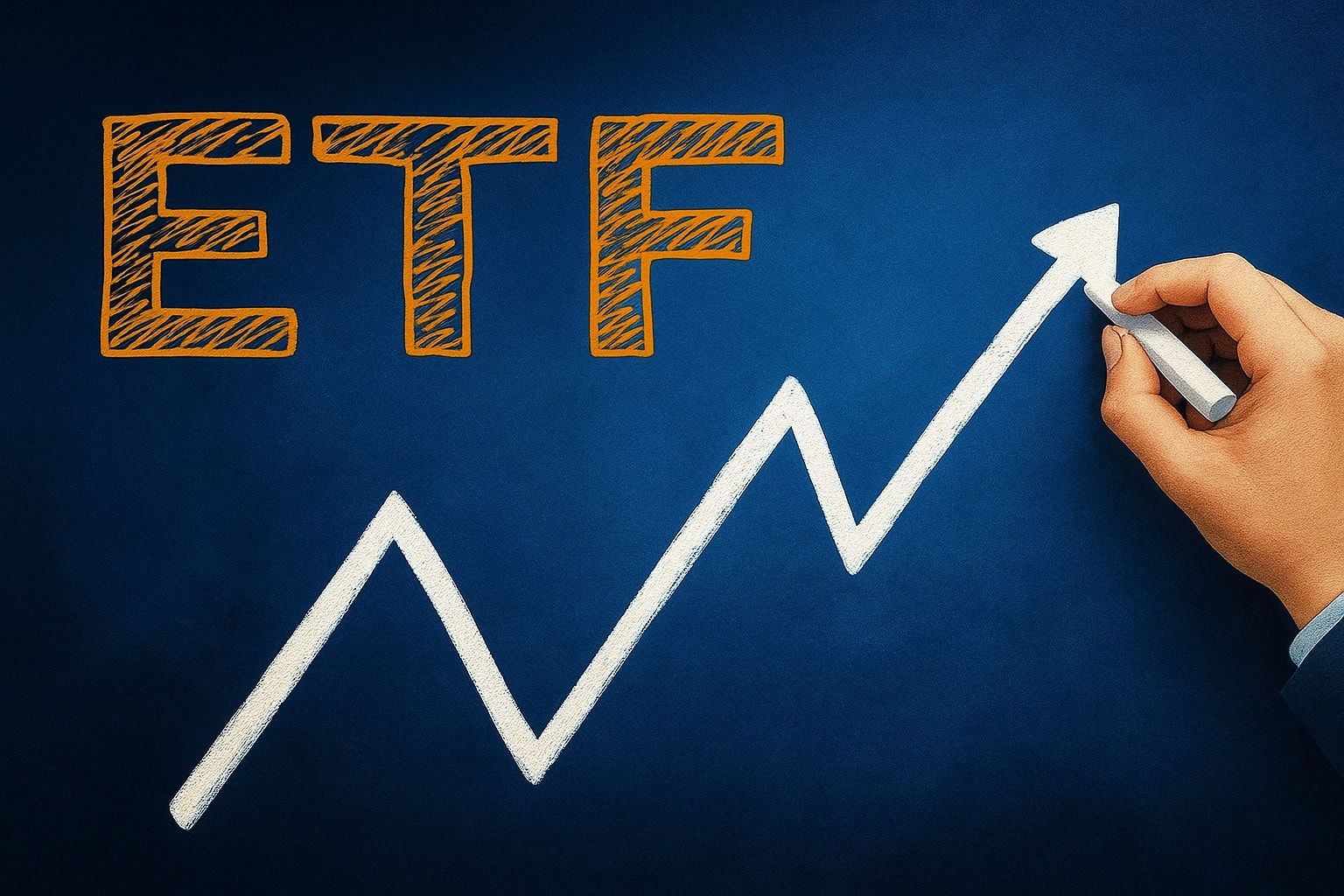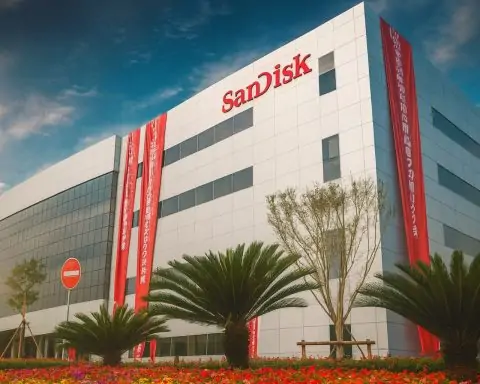- Dividend ETFs provide diversified, passive income: Instead of picking individual stocks, investors can buy dividend-focused exchange-traded funds (ETFs) that hold hundreds of dividend-paying companies. These funds offer instant diversification and regular payouts (dividends) on top of any share price gains [1].
- Stable yields with low fees: Popular funds like the Schwab U.S. Dividend Equity ETF (SCHD) yield around 3.9% annually and charge an ultra-low 0.06% fee [2]. In contrast, an actively managed option-income fund like JPMorgan Equity Premium Income ETF (JEPI) yields roughly 8.6% by using a unique strategy (selling options) – though it comes with a higher 0.35% expense ratio [3] [4]. (As of early Nov 2025, SCHD trades around $26.5 per share [5], VYM about $139 [6], and JEPI near $57 [7].)
- $500 monthly can grow into a $680,000 nest egg: Consistently investing $500 per month into a quality dividend ETF can compound dramatically over time. One analysis found that this strategy could build roughly $680,000, which would then pay around $21,000 per year in dividends alone [8]. (This assumes the fund continues to deliver strong returns and dividends are reinvested — while not guaranteed, historically some dividend ETFs have achieved this.)
- Market shifts favor dividend/value stocks: In late 2025, the Federal Reserve’s interest-rate cuts have prompted investors to rotate into high-dividend and value stocks [9]. Dividend ETFs benefited from this trend – for example, SCHD is roughly flat (+0.7% YTD) after lagging earlier in the year [10]. Analysts remain optimistic: SCHD carries a Moderate Buy rating and a consensus price target ~$30.50 (about 14% above recent levels) [11], and other dividend ETFs like JEPI also have double-digit upside forecasts [12].
- Eye-popping yields come with risks: Niche funds exist with extremely high yields (well above 10%). In fact, 92 ETFs sported yields over 5% in a recent screening [13]. Some of the highest were new “option-income” ETFs like the YieldMax TSLA Strategy ETF (TSLY), with a staggering ~98% yield [14]. However, ultra-high yields often signal high risk – for example, TSLY’s one-year total return was -34%, meaning investors lost principal even as they collected outsized payouts [15]. The takeaway: don’t chase yield blindly – consistently high payouts can come at the cost of price declines or complex strategies.
Why Dividend ETFs for Lifetime Income?
Dividend-focused ETFs have become go-to tools for investors seeking steady retirement income. By buying a single ETF, you get exposure to a basket of companies that regularly distribute profits to shareholders as dividends. This means instant diversification and a smoother income stream than relying on one or two stocks. These funds are managed by professionals and often track indexes of dividend-paying firms [16], so investors can “set and forget” while collecting payouts.
Another appeal is stability. Dividend-paying companies tend to be established, profitable businesses (think blue-chip stocks) that can weather economic ups and downs. While their stock prices still fluctuate, the dividends provide tangible returns even in flat or down markets. This makes dividend ETFs popular for those wanting to “live off the interest” in retirement or supplement their income without selling shares.
Crucially, dividend ETFs come in different flavors – from broad-market funds with moderate yields to specialized funds with very high yields. As of November 2025, share prices for these ETFs vary widely (e.g. around $26–$27 for SCHD vs. ~$140 for VYM) [17] [18], but the yield percentage is what income investors focus on. Typical broad dividend ETFs yield on the order of 2–4%, whereas some specialty funds yield much more. In the next section, we’ll explore some top dividend ETF choices and what they offer.
Top 5 Dividend ETFs for a Lifetime of Income
What are some of the best dividend ETFs to consider? Here are five highly regarded funds – each with a different approach – that collectively can form a robust, income-generating portfolio:
- Schwab U.S. Dividend Equity ETF (SCHD) – The All-Star Dividend Fund. SCHD is one of the most popular dividend ETFs, investing in 80 high-quality U.S. companies from the Dow Jones Dividend 100 Index [19]. The fund focuses on stocks with strong financials and consistent dividends, emphasizing defensive sectors like consumer staples, energy, and healthcare that tend to stay stable even in turmoil [20]. SCHD’s top holdings include familiar names (Cisco, PepsiCo, Home Depot) [21]. It currently yields about 3.9% and stands out for its very low fee (0.06%), making it a cost-effective core holding [22]. In short: SCHD offers a blend of stability, quality, and yield at minimal cost.
- Vanguard High Dividend Yield ETF (VYM) – Broad and Diversified. Vanguard’s VYM casts a wide net, holding over 500 stocks with above-average dividends [23]. It mirrors the FTSE High Dividend Yield Index, covering large U.S. companies across sectors – from financials to tech – with top positions like Broadcom, JPMorgan Chase, and Microsoft [24]. VYM’s appeal is diversification + low costs: it matches SCHD’s tiny 0.06% expense ratio [25]. The trade-off is a slightly lower yield (~2.5% currently) [26], since it holds many mega-cap stocks that pay modest dividends. Still, VYM’s performance has been solid (nearly 13% year-to-date return as of late 2025) [27]. Many investors pair VYM with SCHD – the combination adds more sector breadth and hundreds of holdings, creating a stable income foundation [28].
- Vanguard International High Dividend Yield ETF (VYMI) – Going Global for Higher Income. Thus far we’ve covered U.S.-focused funds, but adding international exposure can boost yield and diversification. VYMI holds dividend-paying stocks from outside the U.S. – its portfolio spans developed and emerging markets, with major allocations to countries like the UAE, Austria, and Australia [29]. It tracks an all-world ex-US high dividend index. VYMI does have a slightly higher fee (0.17%) [30], but in return offers a heftier yield (around 3.9% currently) [31]. This ETF is a great complement to SCHD or VYM, since it taps into global income streams that U.S. funds miss. By including VYMI, an investor can secure dividend checks from around the world – and potentially capture opportunities in markets where yields are even higher than in the U.S. [32]
- SPDR Portfolio S&P 500 High Dividend ETF (SPYD) – Top 80 High-Yield Blue Chips. SPYD cherry-picks the 80 highest-yielding companies in the S&P 500 index [33]. It’s essentially a concentrated bet on the biggest dividend payers among large-cap U.S. stocks. This gives SPYD a robust yield (~4.6%) [34] – higher than broad funds like VYM – and its sector mix often leans toward utilities, real estate, and other traditionally high-yield areas. Despite focusing on yield, SPYD has also delivered admirable growth; it achieved an impressive ~15% annual return over the past five years [35]. And it does so at a rock-bottom 0.07% fee. SPYD can be a valuable income booster in a portfolio, though investors should note it’s less diversified (only 80 stocks) and can be overweight in certain sectors. Still, for a simple “buy and hold” income strategy, SPYD has been a reliable performer [36].
- JPMorgan Equity Premium Income ETF (JEPI) – High Yield, Smart Strategy. JEPI takes a unique approach: it not only invests in a portfolio of large-cap U.S. stocks, it also generates income by selling options (covered calls) on the market [37]. This strategy allows JEPI to produce a very high yield (around 8–9%) [38], far above most equity ETFs. Notably, JEPI is actively managed (unlike the index-tracking funds above) – its managers hand-pick stocks they believe are undervalued and use derivatives to enhance income [39] [40]. Top holdings have included mega-caps like Nvidia, Alphabet (Google), and Microsoft [41]. The downside? Active management and complex strategy mean a higher 0.35% expense ratio [42], and the option strategy can cap upside if the market rallies strongly. JEPI has become popular for retirees because of its monthly payouts and ~8% yield, but it should be used with understanding of its strategy. It’s an excellent tool for income – even “cashflow” comparable to some bonds – but not designed for maximum growth.
Key takeaway: These five ETFs each excel in different ways – SCHD, VYM, and SPYD for solid core U.S. dividends, VYMI for global income, and JEPI for a big yield kick. All of them can help an investor build a “paycheck portfolio” that spins off cash year after year.
How $500 a Month Could Become a $680,000 Portfolio
One of the most compelling aspects of dividend ETF investing is the power of compounding. By reinvesting dividends and contributing regularly, even modest investments can snowball into substantial wealth. A recent analysis highlighted this by asking: What if you put $500 per month into a high-quality dividend ETF and just stuck with it? The answer: you might end up with about $680,000 over the long term, which in turn could throw off roughly $21,000 in annual dividends to fund your lifestyle [43].
The ETF singled out in that example is the Schwab U.S. Dividend Equity ETF (SCHD), thanks to its strong historical performance. SCHD has “historically delivered results” that make that $680k goal plausible, according to The Motley Fool’s analysis [44]. Of course, this isn’t a guarantee – markets can be volatile and future returns may differ – but SCHD’s track record shows how consistent growth + dividends can compound impressively. Over the past decade, SCHD has returned around 12–13% annually (with dividends reinvested), which is why it’s a favorite in these hypotheticals.
Let’s break down the math briefly: Invest $500 every month for, say, 25–30 years, and assume an average annual total return of about 8–10%. Thanks to compounding, you could indeed cross the half-million mark. Reaching $680k likely assumes a few decades of steady investing and reinvesting all dividends. The beauty is that by the time you’ve amassed that principal, the dividends alone provide a sizable income. $21k a year from dividends is about $1,750 per month – a meaningful supplement (or even core) to one’s retirement income, without having to sell shares.
This example underscores a key point: dividend ETFs are not just about income today, but income tomorrow. Reinvesting the payouts to buy more shares means your dividend stream grows larger each quarter, like a snowball rolling downhill. For anyone with a long-term horizon, a disciplined plan (e.g. auto-investing a few hundred dollars monthly into a dividend ETF) can potentially yield financial independence.
(Important caveat: Actual results will depend on market returns. There are no sure things in investing, and one should be prepared for ups and downs. That said, the combination of regular contributions, reinvested dividends, and time is a proven recipe for wealth creation.)
High-Yield ETF Opportunities and Risks
With interest rates having been relatively high in recent years, some investors have sought out higher-yielding ETFs to boost their income. There are now specialized funds that advertise eye-catching yields – often in the double-digits. However, it’s crucial to understand how they generate those yields and the risks involved.
A recent ETF Database report compiled a list of high-yield prospects and found 92 ETFs offering yields above 5% [45]. The highest yields belonged to a new class of ETFs that use derivative strategies on single stocks. For example, the YieldMax TSLA Option Income Strategy ETF (TSLY) aims to capture income from Tesla’s volatility. The result? TSLY sported a jaw-dropping ~97.8% dividend yield in October 2025 [46]. Similarly, funds like MSTX (tied to MicroStrategy stock) and NVDY (Nvidia) were yielding 80%+ [47].
While those numbers are real, they come with a big asterisk. These funds achieve such yields by selling call options or using leverage, essentially trading away potential future gains for immediate income. If the underlying stock soars, the fund sacrifices upside (and in some cases, the fund’s strategy can even lead to principal erosion). In TSLY’s case, its nearly 98% yield came at the cost of a –34% one-year total return for investors [48]. In other words, an investor who put $100 in TSLY a year ago might have gained $98 in dividends but seen the share value drop by $34 – netting +$64, or +64%, which sounds great until you consider the broader context (and higher risk and tax complexity).
The lesson: be wary of chasing ultra-high yields. Often, a super high yield indicates the market expects the fund’s payouts to be unsustainable or the underlying assets to drop in value. Some high-yield ETFs invest in risky areas like junk bonds, emerging markets, or use leverage – all of which can amplify losses in bad times. Others, like covered call ETFs (e.g. JEPI, QYLD for Nasdaq-100, etc.), trade upside for income – they tend to lag in bull markets.
That said, high-yield ETFs can serve a purpose. Funds like JEPI (8%+ yield) or even certain real estate or infrastructure ETFs yielding 6–8% provide hefty income streams that many retirees find attractive, especially when bond yields were low. The key is to use them in moderation and understand what you own. A balanced approach might pair a core of stable dividend ETFs (like the five discussed earlier) with a dash of higher-yield funds to bump up the income – without betting the farm on any one risky strategy.
Outlook: Dividend ETFs in the Current Market
As we move through late 2025, what’s the outlook for dividend ETFs and income investors? The macro environment is shifting in ways that could enhance the appeal of dividend stocks. Notably, the Federal Reserve has started to cut interest rates after a period of inflation-fighting hikes [49]. If this trend continues, bond yields may gradually fall, and income investors might flock back to dividend-paying equities to secure yield. Indeed, there are early signs of investors rotating into value and dividend stocks now that the rate cycle has turned a corner [50].
Dividend ETFs like SCHD, which had underperformed growth-heavy indices during the tech-led rally, may see renewed interest. SCHD in particular spent much of 2025 lagging (even posting slight negative returns at times [51]), largely because its portfolio tilts toward financials and industrials rather than the high-flying tech names. However, experts suggest a rebound could be on the horizon. With high interest rates softening, many of SCHD’s value-oriented holdings (think banks, energy, consumer staples) stand to benefit. In fact, on the news of Fed easing, SCHD ticked up modestly in early November [52].
From a fundamentals perspective, corporate earnings for many dividend payers remain solid. The big question mark is the economy: if a recession hits in 2026, dividend stocks could face pressure (companies might even trim dividends if profits fall significantly). Yet, history shows that dividend growers and aristocrats (companies with long records of raising dividends) often hold up better than most in downturns – their steady cash flows and defensive nature make them relative havens.
On the analyst front, sentiment is cautiously optimistic. Wall Street’s consensus 12-month forecasts for major dividend ETFs imply decent upside. For example, SCHD is projected to rise about +14% to roughly $30.5/share [53], according to a composite of analyst targets for its holdings. Similarly, JEPI’s holdings indicate roughly +15–16% upside on average [54]. Price targets can be taken with a grain of salt, but they reflect an expectation that many dividend-paying stocks are undervalued at current prices. Blogger and investor commentary also remains bullish on the income aspect – even if markets stay volatile, getting paid 3–5% (or more) in yield provides a cushion and tangible returns for shareholders.
Investors should also watch sector trends. Dividend ETFs heavy in sectors like utilities, real estate, and consumer staples could get a boost if interest rates come down (reducing their financing costs and making their steady yields more attractive). On the other hand, if the economy re-accelerates, more cyclical dividend sectors (energy, industrials, financials) might outperform – which would also help funds like SCHD and SPYD. In essence, dividend ETFs are not monolithic: their fortunes will ebb and flow with their sector exposures. A well-balanced set of dividend ETFs (like the mix of SCHD/VYM/VYMI/SPYD/JEPI we discussed) covers a broad spectrum, which can help smooth out the ride.
Conclusion
Dividend ETFs have proven to be powerful tools for building wealth and generating income. They offer one-click access to diversified portfolios of income-producing stocks, making it easier than ever for regular investors to “get paid to hold” their investments. By combining a few complementary ETFs, one can create a robust income portfolio that taps into U.S. and international markets, high-yield strategies, and both defensive and growth-oriented dividend payers.
As one analyst summed up, ETFs like SCHD, VYM, and SPYD provide stability and solid yields, VYMI adds international diversification, and JEPI delivers the highest payouts – any of these can help supply a lifetime of income [55]. The key is alignment with your goals: whether you’re seeking to maximize current income, grow a nest egg for the future, or strike a balance between the two, there’s likely a dividend ETF (or a mix of them) suited to your needs.
Looking ahead, the combination of consistent investing, dividend reinvestment, and prudent ETF selection can put financial independence within reach. Dividend ETFs are not flashy; they won’t double your money overnight. What they can do is provide a reliable engine of wealth accumulation and cash flow, turning the stock market’s inherent volatility into a steady stream of tangible returns. For many investors – especially those planning for retirement or craving financial freedom – that makes dividend ETFs a compelling cornerstone of their strategy.
Bottom line: Get paid while you wait. By harnessing the income and growth from quality dividend ETFs, you can let time and compounding do the heavy lifting, ultimately enjoying the fruits in the form of ever-growing dividend checks – potentially for the rest of your life. [56]
Sources: Financial analysis from Yahoo Finance/24/7 Wall St. [57] [58]; The Motley Fool (Nov 3, 2025) [59]; ETF Database (Oct 29, 2025) [60] [61]; TipRanks/analyst forecasts [62] [63]; Investing.com (pricing data) [64]; StockAnalysis (pricing & yield data) [65] [66].
References
1. 247wallst.com, 2. 247wallst.com, 3. 247wallst.com, 4. 247wallst.com, 5. stockanalysis.com, 6. www.investing.com, 7. www.tipranks.com, 8. www.sharewise.com, 9. www.tipranks.com, 10. www.tipranks.com, 11. www.tipranks.com, 12. www.tipranks.com, 13. etfdb.com, 14. etfdb.com, 15. etfdb.com, 16. 247wallst.com, 17. stockanalysis.com, 18. www.investing.com, 19. 247wallst.com, 20. 247wallst.com, 21. 247wallst.com, 22. 247wallst.com, 23. 247wallst.com, 24. 247wallst.com, 25. 247wallst.com, 26. 247wallst.com, 27. 247wallst.com, 28. 247wallst.com, 29. 247wallst.com, 30. 247wallst.com, 31. stockanalysis.com, 32. 247wallst.com, 33. 247wallst.com, 34. stockanalysis.com, 35. 247wallst.com, 36. 247wallst.com, 37. 247wallst.com, 38. 247wallst.com, 39. 247wallst.com, 40. 247wallst.com, 41. 247wallst.com, 42. 247wallst.com, 43. www.sharewise.com, 44. www.sharewise.com, 45. etfdb.com, 46. etfdb.com, 47. etfdb.com, 48. etfdb.com, 49. www.tipranks.com, 50. www.tipranks.com, 51. public.com, 52. www.tipranks.com, 53. www.tipranks.com, 54. www.tipranks.com, 55. 247wallst.com, 56. 247wallst.com, 57. 247wallst.com, 58. 247wallst.com, 59. www.sharewise.com, 60. etfdb.com, 61. etfdb.com, 62. www.tipranks.com, 63. www.tipranks.com, 64. www.investing.com, 65. stockanalysis.com, 66. stockanalysis.com







